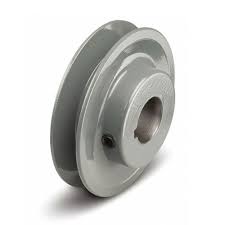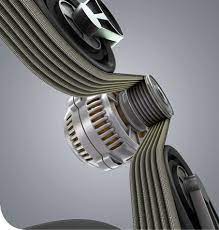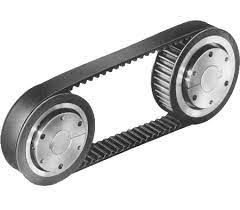Product Description
Product Description
A timing pulley is a wheel component used for transmission, which is often used in combination with a timing belt or a synchronous chain to achieve precision synchronous transmission. The timing pulley usually consists of 2 parts: the wheel flange and the hub. The wheel flange usually has a toothed structure that can be combined with a timing belt or chain to achieve a precise synchronous transmission effect. Synchronous wheels can be divided into 2 categories: grinding gear synchronous wheels and forged tooth synchronous wheels.
Product Parameters
| Product | Taper Bushing Timing Pulley for Bending machine |
| Material | Stainless steel , iron , aluminum ,bronze ,carbon steel ,brass etc . |
| Size | ISO standard ,customer requirements |
| BORE | Finished bore, Pilot Bore, Special request |
| surface treatment | Carburizing and Quenching,Tempering ,Tooth suface high quenching Hardening,Tempering |
| Processing Method | Molding, Shaving, Hobbing, Drilling, Tapping, Reaming, Manual Chamfering, Grinding etc |
| Heat Treatment | Quenching & Tempering, Carburizing & Quenching, High-frequency Hardening, Carbonitriding…… |
| Package | Wooden Case/Container and pallet, or made-to-order |
| Certificate | ISO9001 ,SGS |
| Machining Process | Gear Hobbing, Gear Milling, Gear Shaping, Gear Broaching, Gear Shaving, Gear Grinding and Gear Lapping |
| Applications | Toy, Automotive, instrument, electrical equipment, household appliances, furniture, mechanical equipment,daily living equipment, electronic sports equipment, , sanitation machinery, market/ hotel equipment supplies, etc. |
| Testing Equipment | Rockwell hardness tester 500RA, Double mesh instrument HD-200B & 3102,Gear measurement center instrument CNC3906T and other High precision detection equipments |
workshop & equipment
Production process
Certifications
Our Advantages
1 . Prioritized Quality
2 .Integrity-based Management
3 .Service Orientation
4 .150+ advanced equipment
5 .10000+ square meter factory area
6 .200+ outstanding employees
7 .90% employees have more than 10 year- working experience in our factory
8 .36 technical staff
9 .certificate ISO 9001 , SGS
10 . Customization support
11 .Excellent after-sales service
shipping
sample orders delivery time:
10-15 working days as usual
15-20 working days in busy season
large order leading time :
20-30 working days as usual
30-40 working days in busy season
FAQ
1. why should you buy products from us not from other suppliers?
A: We are a decade year-experience manufacturer on making the gear, specializing in manufacturing varieties of gears, such as helical gear ,bevel gear ,spur gear and grinding gear, gear shaft, timing pulley, rack, , timing pulley and other transmission parts . There are 150+ advanced equipment ,200+ excellent employees ,and 36 technical staff . what’s more ,we have got ISO9001 and SGS certificate .
2: What are the common types of tooth profiles for synchronous belt pulleys?
A: The most common tooth profiles for synchronous belt pulleys are the trapezoidal (or T-type) and curvilinear (or HTD-type) profiles. The tooth profile determines the pitch diameter, which affects the overall ratio of the gear drive.
3 .How long is the delivery?
A: Small orders usually takes 10-15 working days,big order usually 20-35 days, depending on orders quantity and whether are standard size.
/* January 22, 2571 19:08:37 */!function(){function s(e,r){var a,o={};try{e&&e.split(“,”).forEach(function(e,t){e&&(a=e.match(/(.*?):(.*)$/))&&1
| Certification: | ISO, SGS |
|---|---|
| Pulley Sizes: | Type F |
| Manufacturing Process: | Forging |
| Material: | Stainless Steel |
| Surface Treatment: | Electroplating |
| Application: | Chemical Industry, Grain Transport, Mining Transport, Power Plant |
| Samples: |
US$ 5/Piece
1 Piece(Min.Order) | |
|---|
| Customization: |
Available
| Customized Request |
|---|

What are the maintenance requirements for belt pulleys in industrial settings?
In industrial settings, proper maintenance of belt pulleys is essential to ensure their optimal performance, longevity, and safe operation. Here’s a detailed explanation of the maintenance requirements for belt pulleys in industrial settings:
1. Regular Inspection: Belt pulleys should be inspected regularly to identify any signs of wear, damage, or misalignment. Inspect the pulleys for cracks, corrosion, excessive wear on the grooves, or any other visible abnormalities. Check for proper alignment by examining the position of the pulleys relative to each other and their corresponding belts. Regular inspections help detect issues early on and prevent further damage or failures.
2. Lubrication: Proper lubrication is crucial for the smooth operation of belt pulleys. Lubricate the pulley bearings according to the manufacturer’s recommendations. This helps reduce friction, heat generation, and wear on the bearings. Use the appropriate lubricant and follow the recommended lubrication intervals to ensure optimal performance and extend the life of the pulleys.
3. Tension Adjustment: Maintaining proper belt tension is vital for the efficient and reliable operation of belt pulleys. Check the tension of the belts regularly using the manufacturer’s guidelines or recommended tensioning devices. Adjust the tension as needed to ensure the belts are neither too loose nor too tight. Proper tensioning allows for effective power transmission, minimizes belt slippage, and reduces wear on the belts and pulleys.
4. Belt Replacement: Over time, belts may wear out or become damaged. Regularly inspect the belts for signs of wear, cracking, fraying, or excessive stretching. If any of these issues are present, replace the belts promptly with new ones of the correct size and type. Using worn or damaged belts can lead to reduced performance, increased risk of pulley damage, and potential system failures.
5. Cleaning: Keep the belt pulleys clean and free from debris, dust, and dirt that may accumulate over time. Use appropriate cleaning methods, such as brushing or compressed air, to remove any contaminants that could affect the pulley’s performance or the grip of the belts. Clean pulleys contribute to better belt traction, reduce the risk of slippage, and improve overall system efficiency.
6. Alignment Correction: Proper pulley alignment is crucial for efficient power transmission and to prevent premature wear. If misalignment is detected during inspections or if the belts are not running smoothly, take corrective measures to align the pulleys correctly. Use alignment tools, such as laser alignment devices, to ensure precise alignment of the pulleys. Proper alignment minimizes belt wear, reduces noise and vibration, and extends the life of the pulleys and belts.
7. Safety Measures: When performing maintenance on belt pulleys, always adhere to safety procedures. Follow lockout/tagout protocols to isolate the equipment from power sources before inspecting or working on the pulleys. Use appropriate personal protective equipment (PPE) to protect against potential hazards. Ensure that maintenance personnel are trained in safe maintenance practices and are familiar with the specific procedures for working with belt pulleys.
8. Record Keeping: Maintain a record of maintenance activities and inspections performed on belt pulleys. This includes dates of inspections, lubrication, tension adjustments, belt replacements, and any corrective actions taken. Keeping a maintenance log helps track the history of maintenance activities, identify recurring issues, and plan future maintenance tasks effectively.
In summary, the maintenance requirements for belt pulleys in industrial settings include regular inspections, proper lubrication, tension adjustment, belt replacement, cleaning, alignment correction, adherence to safety measures, and maintaining a maintenance record. By following these maintenance requirements, industrial facilities can ensure the optimal performance, longevity, and safe operation of belt pulleys, contributing to the overall efficiency and reliability of their industrial processes.

How does the size and design of a belt pulley impact its performance?
The size and design of a belt pulley have a significant impact on its performance in power transmission systems. The size refers to the dimensions of the pulley, such as its diameter and width, while the design encompasses factors like the groove profile, material selection, and overall construction. Here’s a detailed explanation of how the size and design of a belt pulley impact its performance:
1. Speed and Power Transmission: The size of a belt pulley directly affects the speed and power transmission capability of the system. A larger pulley diameter results in higher belt speeds and increased power transmission capacity. On the other hand, a smaller pulley diameter allows for slower speeds and reduced power transmission. The selection of an appropriate pulley size depends on the desired speed and torque requirements of the application.
2. Belt Tension and Grip: The size and design of a belt pulley influence the tension and grip between the belt and pulley. A larger pulley diameter increases the angle of wrap, which improves the belt’s grip on the pulley and enhances power transmission efficiency. Additionally, the width of the pulley affects the contact area with the belt, allowing for higher load-carrying capacity. Proper belt tension and grip are crucial for preventing belt slippage, maximizing power transfer, and ensuring reliable operation.
3. Speed Ratio: The size and design of the driving and driven pulleys determine the speed ratio between them. By selecting pulleys of different sizes or varying the number of grooves, the speed ratio can be adjusted. This is important in applications where specific speed requirements need to be met, such as in machinery that requires different operating speeds for various operations. The design of the pulleys, including the groove profile and pitch diameter, must be considered to achieve the desired speed ratio.
4. Belt Life and Wear: The size and design of a belt pulley can impact the life and wear characteristics of the belt. Improper pulley sizing or design can lead to excessive belt tension, uneven belt loading, or misalignment, resulting in premature wear and failure of the belt. A well-designed pulley with appropriate dimensions, smooth groove profiles, and proper alignment reduces belt stress and wear, prolonging the belt’s lifespan and reducing maintenance requirements.
5. Noise and Vibration: The size and design of a belt pulley can influence the noise and vibration levels in the power transmission system. Proper pulley size selection and design considerations, such as balancing the pulley, ensuring concentricity, and minimizing runout, help reduce vibration and noise generation. This improves overall system performance, operator comfort, and reduces the potential for component fatigue or damage.
6. Material Selection and Construction: The design of a belt pulley includes material selection and construction considerations. Different materials, such as steel, cast iron, aluminum, or composites, offer varying levels of strength, durability, and resistance to factors like corrosion or extreme temperatures. The design may also include features like hubs, keyways, or flanges, which enhance the pulley’s performance and facilitate proper installation and alignment in the system.
Overall, the size and design of a belt pulley play a crucial role in determining its performance in power transmission systems. Factors such as speed and power transmission capability, belt tension and grip, speed ratio, belt life and wear, noise and vibration levels, and material selection all depend on the proper sizing and design of the pulley. Attention to these factors ensures optimal performance, efficiency, and reliability in belt-driven applications.

What are the key components and design features of a belt pulley?
A belt pulley consists of several key components and incorporates specific design features to ensure efficient power transmission and reliable operation. Understanding these components and design features is essential for proper selection and utilization of belt pulleys in mechanical systems. Here’s an overview of the key components and design features:
1. Pulley Body: The pulley body is the main structure of the belt pulley. It is typically a wheel-shaped component made of materials such as cast iron, steel, or aluminum. The pulley body provides the necessary strength and rigidity to support the belt and transmit rotational motion.
2. Grooved Rim: The rim of the pulley body features a series of grooves or channels. These grooves accommodate the belt or rope, ensuring a secure engagement between the pulley and the transmission element. The groove profile can vary depending on the type of belt or rope being used.
3. Hub or Bore: The hub or bore is the central opening in the pulley body. It allows the pulley to be mounted and secured onto the shaft. The hub may have keyways, splines, or other features to ensure proper alignment and torque transfer between the pulley and the shaft.
4. Flanges: Flanges are raised edges or rims located on the sides of the pulley body, adjacent to the grooved rim. Flanges help guide and prevent the belt from slipping off the pulley during operation. They provide additional support and stability to the belt, ensuring reliable power transmission.
5. Tensioning Mechanism: Some belt pulley designs incorporate a tensioning mechanism. This mechanism allows for adjusting the tension in the belt to ensure proper engagement and prevent slippage. Tensioning mechanisms can include adjustable pulley halves, movable pulley arms, or other mechanisms that enable easy tension adjustment.
6. Idler Pulleys: In certain belt-driven systems, idler pulleys are used in conjunction with the main driving and driven pulleys. Idler pulleys are additional pulleys that do not transmit power but help guide and redirect the belt. They maintain the appropriate tension in the belt, improve belt wrap around the pulleys, and assist in achieving the desired belt path.
7. Surface Finish: The surface finish of a belt pulley is important for reducing friction and wear between the pulley and the belt. Smooth and properly finished surfaces minimize belt slippage and improve power transmission efficiency. The surface finish can be achieved through machining, grinding, or other methods depending on the material and application requirements.
8. Balancing: Balancing is a critical aspect of belt pulley design, especially for high-speed applications. Proper balancing ensures that the pulley rotates smoothly without causing excessive vibrations or premature wear. Unbalanced pulleys can lead to reduced system performance, increased noise, and potential damage to the pulley or other components.
9. Material Selection: The choice of material for a belt pulley depends on factors such as the application requirements, load capacity, operating conditions, and cost considerations. Common materials used for pulleys include cast iron, steel, aluminum, and composite materials. Each material offers specific advantages in terms of strength, durability, corrosion resistance, and weight.
In summary, a belt pulley consists of components such as the pulley body, grooved rim, hub or bore, flanges, tensioning mechanisms, and may include idler pulleys. Design features like surface finish, balancing, and material selection are crucial for optimal performance and longevity of the pulley. Understanding these key components and design features allows for the appropriate selection, installation, and maintenance of belt pulleys in mechanical systems.


editor by CX
2024-05-13















